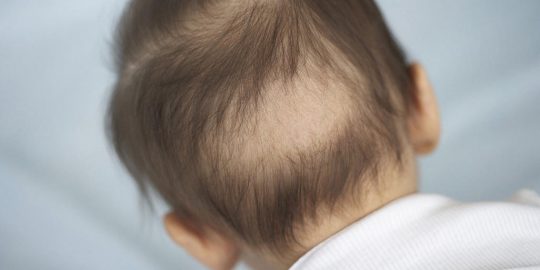Hair loss in Children

- Friday 8th January, 2021
- | Uncategorized
Coronavirus Disease 2019 (COVID- 19) is caused by severe acute respiratory syndrome coronavirus 2 (SARS-CoV-2). The disease can be a cause of a range of different dermatologic manifestations. It also raises many critical issues in treatment and care of dermatological ailments.
CUTANEOUS MANIFESTATIONS OF COVID- 19
There is no certainty about frequency of occurrence (0.2- 20.4%) and the timing of cutaneous manifestations when one suffers from COVID- 19. Moreover, there is an unclear association between skin manifestations and illness severity. We also have to remember that some patients developing skin findings, may get them due to cutaneous reactions to treatments given for COVID- 19.
Most common cutaneous manifestations
Exanthematous (Morbilliform) rash (22%)-
- It predominantly involves trunk.
- Can occur at the disease onset or, more frequently, after discharge from the hospital or during recovery.
Pernio (Chilblain)- like acral lesions (18%)- Also known as ‘COVID toes’
- It presents as erythematous-violaceous or purpuric macules on fingers, elbows, toes, and lateral aspect of feet, with or without accompanying edema and pruritus.
- It occurs in absent of cold exposure or underlying conditions associated with pernio.
- Pathogenesis- It is primarily an inflammatory process. Skin biopsy suggest virus-induced vascular injury.
- It usually occurs in later stage of disease process, ie. Postviral or delayed-onset process after the onset of other COVID- 19 symptoms. So the patient may test positive for immunoglobulin M (IgM) and immunoglobulin G (IgG) antibodies for SARS-CoV- 2 and negative for polymerase chain reaction (PCR) at the time of dermatologic consultation.
- A development of pernio-like lesions in COVID- 19 is associated with relatively mild disease course.
- Treatment- No specific treatment guidelines available. However, high potency topical corticosteroids can provide symptomatic relief.
Fixed livedo racemosa/ retiform purpura/ necrotic vascular lesions (6.4%)-
- It is associated with severe COVID-19.
- Histologic and immunohistochemistry studies of skin biopsy relieved a pattern of complement-mediated microvascular injury in both involved and normally appearing skin.
- Histopathologic findings of thrombotic vasculopathy and/or laboratory coagulation alterations have been seen in patients with severe COVID-19 and acral ischemic lesions.
Urticaria (16%)-
- Acute urticaria with or without concomitant fever has been testified as a presenting sign of COVID- 19 infection.
Vesicular (varicella-like) eruptions (11%)-
- An eruption of small papules, vesicles, and pustules occurs at 4-30 days after the onset of COVID symptoms. It resolves in a median of 10 days.
- Real-time PCR for SARS-CoV- 2 from vesicle content yields negative results.
Multisystem inflammatory syndrome in children (MIS-C)-
- An erythematous, polymorphic rash, erythema and/or firm induration of hands and feet, oral mucositis and conjunctivitis, along with systemic, laboratory, and imaging findings of atypical, severe Kawasaki disease, have been explained.
Other less frequent dermatologic manifestations-
- Papulosquamous eruptions, erythema multiforme-like lesions, dengue-like rashes, petechiae and gangrene.
- Some infants born to mothers with COVID- 19 at birth have had transient rash. It present as diffuse maculopapular eruption or red, miliaria-like eruption. It resolves with desquamation in 1-10 days without treatment.
DERMATOLOGIC CONDITIONS RELATED TO COVID- 19 PANDEMIC
The general public have started wearing a face mask and using hand hygiene measures which has led to different skin manifestations. The use of personal protective equipment (PPE) by the health care workers in hospitals and test centres for long hours can cause PPE induced skin injuries.
PPE-kit induced skin injuries-
- It is commonly seen in health care workers caring for COVID- 19 patients and the ones wearing PPE for long hours.
- The percentage of its occurrence is as high as- 43-97 %, with an increase rate of skin damage if PPE is used for > 6 hours per day.
- Injuries include- desquamation, mechanical/ friction dermatitis, irritant contact dermatitis, erythema, maceration, fissuring, papules, erosions, leading to itching and pain.
- Masks, goggles, face shields, and gloves apply pressure, can create abrasion, retain moisture and can injure nasal bridge, cheek, forehead and hands.
- PPE can also aggravate underlying skin conditions.
- PPE related injuries can also lead to PPE protocol breaches due to inadvertent adjustment and touching.
- Use of thick barrier cream of zinc oxide or petroleum jelly, or dressings at pressure points before donning PPE-kit is quite beneficial to reduce these types of injuries.
Acne caused by face mask (Maskne)-
- Face masks are now the guaranteed guise to prevent yourself and others from COVID- 19.
- Face masks generate a humid and a sticky environment around your face, leading to acne breakouts around the nose, cheeks, mouth and chin.
- It presents as small pimples, like rosacea.
- The cause of maskne is not a dirty mask, but the bacteria causing acne, that thrives in humid environments created by a face mask. So, it also occurs on the faces of people using a clean cloth mask or surgical disposable masks. Also, the time of wearing a mask doesn’t directly corelate to acne development. Incidence is same among health care workers wearing face mask for eight hours, and people wearing it just to the grocery store.
- To prevent maskne, wash your face with 2-5% benzol peroxide solution. Use non-comedogenic oil-free moisturizer after washing.
Hand hygiene-related dermatitis-
- Hand hygiene is the key tool to protect against COVID- 19. It requires frequent washing of hands (for at least 20 seconds) or use of hand sanitizer (with >70% alcohol).
- Hand eczema can occur among health care workers due to frequent hand wash, or frequent use of hand sanitizer, or due to wearing gloves. These can lead to irritant (and in few cases- allergic) contact dermatitis.
- Frequency of hand dermatitis can be reduced by
- Frequent usage of emollients (e.g. Petroleum jelly)
- Washing with lukewarm water instead of hot water
- Usage of hand sanitizers when hands are not visibly dirty
- Avoid overzealous hand hygiene.
THERAPEUTIC CONSIDERATIONS FOR DERMATOLOGIC DISEASES IN COVID- 19 PANDEMIC
COVID- 19 pandemic has led to necessary adjustments towards a therapeutic approach for certain dermatologic diseases.
Use of biologic and other immunosuppressive therapies-
- Biologic and immunosuppressive therapies are significant in management of a wide range of dermatologic diseases, such as, psoriasis, pemphigus and autoimmune diseases.
- It is accepted that those patients not suffering from COVID- 19, who are already taking immunosuppressive drugs for dermatologic disease, can continue therapy. A more cautious approach is taken for patients who have suspected or confirmed COVID- 19, and those who are considered for starting a new immunosuppressive therapy.
- Assessment of risk-
- Uncertainty regarding impact of biologicals and other immunosuppressive therapies on SARS-CoV- 2 infection risk and COVID- 19 severity makes risk assessment challenging. Challenges that include paucity of data, various different mechanism of action of immunosuppressive drugs, and a need to consider patient-specific and disease-specific morbidity and comorbidities.
- Broad immunosuppressants (e.g. cyclosporine, mycophenolate, azathioprine) are of more concern than targeted immunosuppressants (e.g. biologic drugs).
- Potential risks of immunosuppressive therapies must be balanced with the detrimental effects on skin disease and associated conditions, that may result from cessation of effective therapies. Cutaneous disease may flare up, and patient may not achieve same level of response upon reintroduction of previously effective biologic therapy.
- Long half-lives of some biologic agents need to be kept in consideration while deciding to halt the therapy.
- Studies have found higher risks for testing positive, for being self-quarantined at home or being hospitalized due to COVID- 19, in patients with immunosuppressive therapy. However the risk for intensive care unit admission or dying in this population is very low.
- Few immunosuppressive drugs are proposed and studied for prevention of organ damage due to COVID- 19. For example, Tumor Necrosis Factor (TNF) alpha, or Interleukin (IL) 17, or IL- 16 pathway inhibitors.
- Oral glucocorticoids are used to prevent cytokine-related (inflammation-mediated) lung injury, to prevent or treat acute respiratory distress syndrome (ARDS), and thereby reducing its progression towards respiratory failure and death, in patients with severe COVID- 19.
- Patients without COVID- 19
- Decisions regarding the use of immunosuppressive therapies in patients without signs or symptoms of COVID- 19 during global pandemic should be made on a case-by-case basis and in conjunction with the patient.
- This may involve reviewing of
- Patient’s comorbidities
- Severity of the disease originally being treated
- Limited available data
- Expert opinion
- Local recommendations and
- Patient preference
- Continuation of immunosuppressive therapies-
- Based upon an absence of evidence that suggests the advantages of discontinuing immunosuppressive therapies in patients without COVID- 19 and the potential detrimental effects of discontinuing effective therapies, the continuation of biologic and small molecule immunosuppressants for dermatologic disease is generally considered a safe and an appropriate option for patients who do not have suspected or documented COVID- 19.(Keep it)
- Initiation of immunosuppressive therapies-
- The decision to start a new immunosuppressive therapy for dermatologic disease should be based on case-specific review of potential risks and benefits of the mentioned therapy.
- There is uncertainty regarding the effects of immunosuppressive therapies on COVID- 19. So, in patients with low risk for COVID- 19, the therapy can be safely considered, while in patients with increased risk of severe COVID- 19, alternative therapies should be considered.
- To be on safer side, you can test patient for SARS-CoV- 2 infection or immunity, prior to the initiation of immunosuppressive therapies.
- Patients with presumed or confirmed COVID- 19-
- Active infection is an indication for discontinuation and avoidance of initiation of immunosuppressive therapies. It can be resumed, if required, following a complete recovery from COVID- 19.
- Following factors should be considered for ceasing the treatment
- Severity of COVID- 19,
- Potential of biologic treatment to reduce risk of cytokine storm,
- Potential negative ramifications of treatment cessation on flaring immunologic activity, including both dermatologic disease and comorbidities.
Phototherapy-
- In- clinic phototherapy involves frequent clinic visits, which potentially increase the exposure of other patients and clinical staff to SARS-CoV- 2. Therefore, it should be avoided, or kept limited by scheduling fix time slots. Use of PPE and correct disinfection of all equipment, should be strictly followed.
- Phototherapy at home is better and is preferred as an alternative during this current pandemic.
Skin cancer-
- This includes Melanoma, Squamous cell carcinoma and Basal cell carcinoma.
- Any patients having advanced skin cancers, surgery or systemic therapies should not be deferred.
DELIVERY OF CARE DURING THE PANDEMIC
There is an evolvement in seeing routine, nonurgent dermatology cases. This pandemic has led to increased use of telemedicine for dermatologic care (i.e. teledermatology).
Teledermatology is a novel method, which reduces the risk of exposure of clinicians, the staff and its patients from COVID- 19 patients. It can be given via telephone, video conferencing or through text messages and sharing of images. One must check that the platform selected for teledermatology is compliant with local privacy regulations.
In-person visits are performed with the correct infection control precautions. They include screening of patients and the use of PPE.
Dermoscopy-
- A noncontact dermoscopy is preferred
- Disinfect dermatoscope with alcohol 1-minute prior and after the examination
- Use polyvinyl chloride food wrap or a glass slide between the lens and the lesion
- Use an alcohol gel as an interface medium
- Use disposable dermoscopic lens covers.
